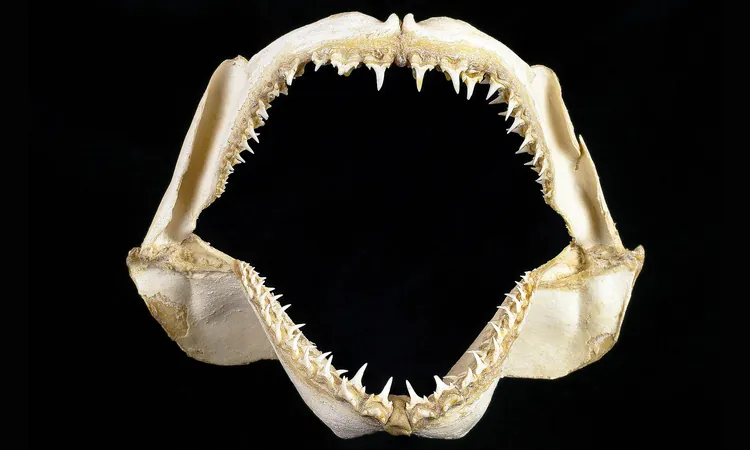
Ancient Shark Jaws Unlock Secrets of Diets and Habitats
2025-03-25
Author: Mei
Sharks, the apex predators of the ocean, have been swimming through Earth’s waters for millions of years. Their formidable jaws and razor-sharp teeth not only enable them to capture their prey but also allow them to play a crucial role in maintaining the balance of marine ecosystems. However, understanding the diets and habitats of these magnificent creatures, especially those that are rare or endangered, has posed significant challenges for scientists. Traditional methods of studying shark diets often involve examining teeth, which can be risky and impractical to procure from live specimens.
Shark Teeth: Nature's Historical Record
Shark teeth contain chemical signatures derived from stable isotopes—naturally occurring variations of chemical elements. By analyzing these isotopes, scientists can reconstruct an animal's ecological past, including what it ate and where it roamed. Previous concerns about cleaning chemicals, such as ethanol and bleaches used on museum specimens possibly altering these isotopes, limited researchers' ability to utilize these jaws effectively.
However, the recent findings indicate that these preservation methods do not compromise the key isotopes necessary for diet studies. As Dr. Lauren Meyer, a research associate from Flinders University, states, "Finding that preservation chemicals had no impact on isotope values opens the door for the use of jaws from historic collections across Australia and globally."
This opens up a realm of possibilities, enabling researchers to examine dietary patterns not only in contemporary settings but also to conduct comparative studies that span different time periods and geographic regions.
Isotope Analysis: Unveiling Feeding Habits
The study employed stable isotope analysis, focusing on carbon, nitrogen, and sulfur isotopes, which aid in understanding a shark's diet and habitat. Lead author Laura Holmes explains that the chemical composition of teeth provides a narrative of a shark’s dining choices, whether they feasted on sea lions in South Australia or tuna in New South Wales.
The team tested jaws from various elasmobranchs including cownose rays, gummy sharks, and broadnose sevengill sharks, all of which successfully held up against isotope testing despite their structural differences.
A Boon for Conservation of Rare Species
This innovative approach is particularly valuable for studying rare and threatened shark species often neglected due to the inability to procure live samples. Trophy jaws collected over the years can serve as alternative data sources, providing insight into the long-term dietary trends of species like white sharks, tiger sharks, and makos.
With many shark species under threat from human activities, climate change, and habitat loss, these older collections from past decades deliver crucial information essential for developing conservation strategies.
Wider Implications for Marine Sciences
Though the study focused primarily on sharks and rays, its implications stretch far beyond these species. Other marine mammals, including killer whales, sperm whales, and fur seals, also have preserved teeth in museum collections that could be subjected to similar analysis. This opens a new frontier in research regarding the feeding patterns and habitats of complex predators within our oceans.
As Dr. Meyer emphasizes, this study paves the way for new research opportunities and expands the toolkit available for scientists investigating marine ecosystems. Every preserved tooth could potentially unveil a fascinating story about our ocean's history.
This research has been published in the journal Marine Environmental Research, marking a significant advance in our understanding of marine life and their evolutionary narratives.
Don't Miss Out!
Subscribe to our newsletter for in-depth articles, exclusive content, and the latest discoveries in marine science!
 Brasil (PT)
Brasil (PT)
 Canada (EN)
Canada (EN)
 Chile (ES)
Chile (ES)
 Česko (CS)
Česko (CS)
 대한민국 (KO)
대한민국 (KO)
 España (ES)
España (ES)
 France (FR)
France (FR)
 Hong Kong (EN)
Hong Kong (EN)
 Italia (IT)
Italia (IT)
 日本 (JA)
日本 (JA)
 Magyarország (HU)
Magyarország (HU)
 Norge (NO)
Norge (NO)
 Polska (PL)
Polska (PL)
 Schweiz (DE)
Schweiz (DE)
 Singapore (EN)
Singapore (EN)
 Sverige (SV)
Sverige (SV)
 Suomi (FI)
Suomi (FI)
 Türkiye (TR)
Türkiye (TR)
 الإمارات العربية المتحدة (AR)
الإمارات العربية المتحدة (AR)